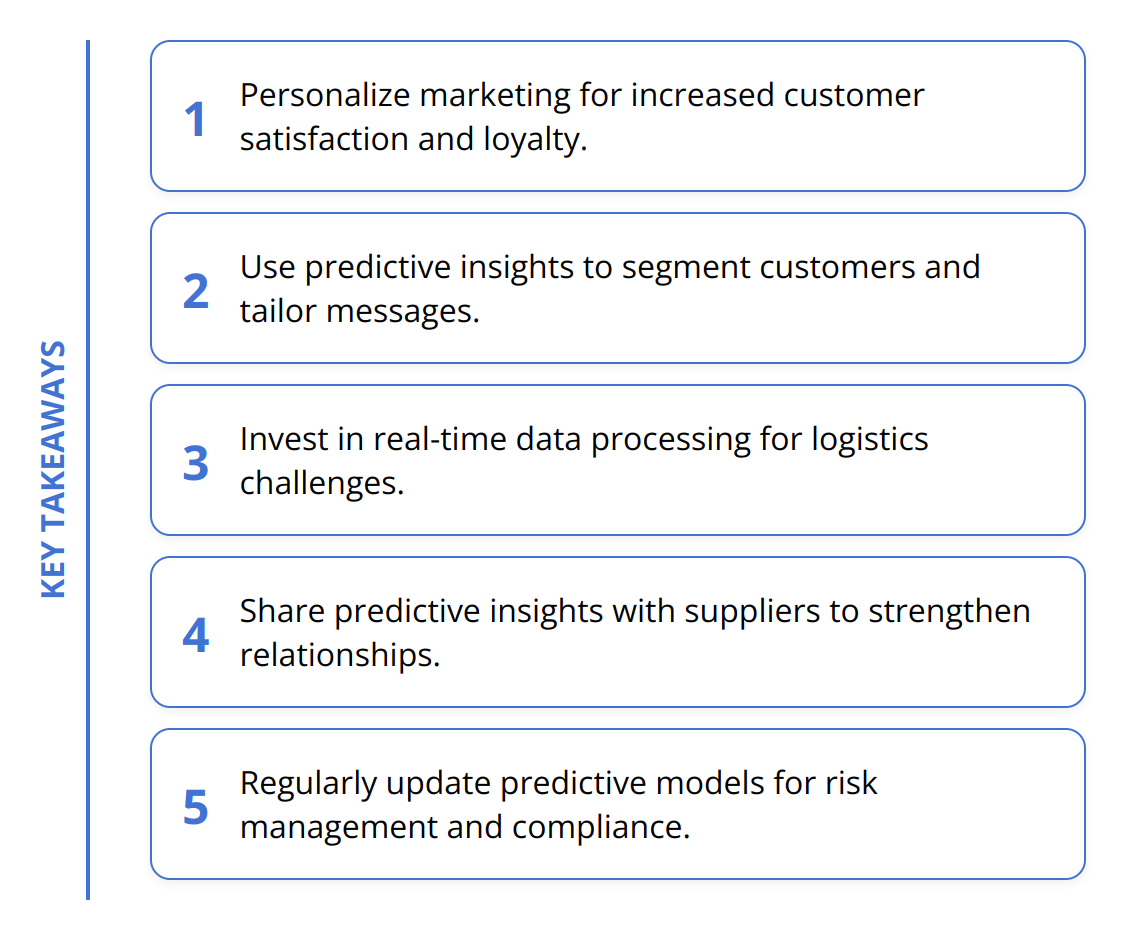The power of predictive analytics in transforming business operations cannot be overstated. It enables organizations to make informed decisions, anticipate future trends and optimize their strategies for better outcomes. We at Emplibot believe that understanding its application across various business areas is key to leveraging its full potential. This blog post explores practical examples of how predictive analytics is making a significant impact in marketing, supply chain management, and risk management.
Predictive Analytics Boosts Marketing
Predictive analytics stands as a game-changer in the marketing realm. It’s all about understanding and predicting customer behaviors to tailor marketing strategies that not only connect but convert. The goal is simple: increase engagement, conversion, and loyalty by predicting what your customers want before they even know it themselves.
Transforming Customer Relationships with Personalization
The ability to personalize customer experiences is no longer just nice to have; it’s expected. By analyzing past customer interactions and behaviors, businesses can predict future preferences and create personalized marketing messages. For example, an online retailer could use predictive analytics to recommend products that a customer is likely to purchase based on their browsing history and past purchases. The result? A significant increase in customer satisfaction and loyalty.

Navigating Market Trends with Precision
In today’s fast-paced market, staying ahead of trends isn’t just about keeping up; it’s about predicting what’s next. Predictive analytics mines data on past customer behaviors and market trends to forecast future demand accurately. This foresight allows businesses to adjust their strategies proactively, ensuring they’re always one step ahead. A well-timed product launch, based on predictive trend analysis, can capture market attention and skyrocket sales.
Strategic Pricing for Maximum Impact
Pricing strategy is crucial in marketing, and predictive analytics provides the competitive edge needed. By analyzing market data, customer sensitivity, and competitor pricing, businesses can optimize their pricing strategies for maximum profit. Dynamic pricing, where prices are adjusted in real-time based on demand and supply, is a perfect example of predictive analytics at work. This strategy not only boosts sales during peak demand but also ensures a steady revenue flow during off-peak seasons.

In integrating predictive analytics into marketing strategies, businesses must focus on the following:
-
Collect and analyze relevant data to understand customer patterns and preferences.
-
Use this insight to create personalized and targeted marketing campaigns.
-
Continually refine your strategies based on predictive outcomes for ongoing improvement.
Practical tips for applying predictive analytics in marketing:
-
Segment your customers based on predictive insights to tailor marketing messages more effectively.
-
Monitor and analyze campaign performance regularly to tweak and optimize for better results.
-
Invest in the right tools that offer robust predictive analytics features.
For those looking to deepen their understanding, exploring resources like predictive analytics in marketing can provide valuable insights and practical steps to get started.
Predictive analytics does not just predict the future; it allows businesses to shape it actively. By understanding and embracing this powerful tool, marketers can unlock unparalleled growth and create more meaningful relationships with their customers.
Elevating Supply Chain with Predictive Analytics
The integration of predictive analytics into supply chain management marks a significant leap towards operational excellence. It’s about transforming how businesses anticipate inventory needs, navigate transport and logistics hurdles, and strengthen supplier relationships. Optimizing these areas leads to remarkable efficiency, cost reduction, and enhanced partnerships.
Streamlining Inventory Management
Anticipating inventory needs with precision is vital. Overstocking ties up unnecessary capital, while understocking can result in missed sales and unsatisfied customers. Predictive analytics offers a proactive approach, analyzing historical sales data, current market trends, and even weather forecasts to accurately predict inventory demand. Implementing these insights leads to smarter inventory decisions, minimizing waste and ensuring product availability.
A practical tip is to regularly update your data sources to include the latest market trends and consumer behavior changes. This ensures your predictive models stay accurate and relevant.
Navigating Transport and Logistics
Predicting transport and logistics challenges before they occur can save businesses from the high costs associated with delays and disruptions. Using predictive analytics, companies can forecast potential delays due to weather conditions, traffic congestion, or geopolitical events, and adjust their logistics plans accordingly. This forward-thinking approach enables more reliable delivery schedules and improves customer satisfaction.
Investing in predictive analytics solutions that offer real-time data processing can significantly enhance your ability to respond to logistics challenges promptly.
Enhancing Supplier Relationship Management
Improving supplier relationship management through predictive analytics leads to stronger, more reliable supply chains. By analyzing supplier performance history and market conditions, businesses can predict potential supply disruptions before they happen and work with suppliers to mitigate risks. This proactive communication builds trust and collaboration between businesses and their suppliers, ensuring a smoother supply chain operation.
A key action point here is to establish clear communication channels with suppliers for sharing predictive insights. This fosters a collaborative environment where both parties can anticipate challenges and work together towards solutions.

Practical Steps to Implement Predictive Analytics in Supply Chain:
-
Integrate diverse data sources, including weather, geopolitical events, and market trends, to strengthen your predictive models.
-
Develop a flexible logistics plan that can quickly adapt based on predictive insights.
-
Foster transparency with your suppliers, sharing relevant predictive insights to ensure collective preparedness.
For further reading on optimizing your supply chain with analytics, explore predictive analytics for B2B sales and understand how to blend these strategies for comprehensive business growth.
Implementing predictive analytics in supply chain management not only enhances operational efficiency but also elevates the overall customer experience by ensuring product availability and timely delivery. It’s an investment that pays dividends in building a resilient, responsive, and competitive business.
Predictive Analytics in Risk Management
Predictive analytics is transforming risk management processes by providing businesses with the foresight to preempt and mitigate risks effectively. In the realm of risk management, predictive analytics serves as a powerful tool to identify potential threats and safeguard operational integrity. It empowers enterprises to proactively address vulnerabilities in compliance, credit risk estimation, and fraud detection, thereby enhancing overall resilience.
Reinforcing Fraud Detection
The fight against fraudulent activities is ongoing and complex. However, with predictive analytics, businesses can shift from reactive to proactive strategies. Analyzing patterns in transaction data helps in identifying anomalies that could indicate fraud. For instance, a sudden spike in high-value transactions from a previously inactive account could trigger a fraud alert. Real-time monitoring systems equipped with predictive analytics can flag such activities instantly, allowing for swift action. Financial institutions and e-commerce platforms are leading examples where predictive analytics has significantly reduced fraud incidents, saving millions annually.
Actionable tip: Implement predictive analytics tools that offer anomaly detection features to monitor transactions in real time.
Navigating Credit Risks with Precision
Credit risk assessment is crucial for financial institutions. Predictive analytics revolutionizes this process by analyzing borrower history, market trends, and even economic indicators to predict future loan performance. This enables lenders to make more informed decisions, reducing defaults and improving portfolio quality. By integrating predictive models, banks can tailor their lending criteria based on predicted risks, aligning with their risk tolerance levels.
Actionable tip: Use predictive analytics to segment borrowers into risk categories, adjusting interest rates or down payment requirements accordingly.
Ensuring Compliance and Avoiding Pitfalls
Regulatory compliance is a dynamic and challenging aspect of risk management. Predictive analytics aids in identifying potential compliance breaches before they occur. By analyzing historical data on previous compliance issues, predictive models can highlight areas of concern, allowing organizations to implement preventative measures. This proactive approach not only safeguards against non-compliance penalties but also reinforces a culture of compliance within the organization.
Actionable tip: Regularly update your predictive models to reflect changes in regulations and compliance standards.
Practical Steps to Implement Predictive Analytics in Risk Management:
-
Train your team on the importance of data quality and integrity in predictive analytics.
-
Collaborate with IT and data science teams to ensure the predictive analytics tools are well-integrated and accessible.
-
Review and adjust your risk management strategies regularly based on insights derived from predictive analytics.
For businesses looking to enhance their risk management capabilities, understanding the applications and benefits of predictive analytics is the first step towards a more secure and resilient operation. By leveraging predictive analytics, companies can not only anticipate and mitigate risks but also position themselves for sustainable growth. Further insights on how predictive analytics aids risk management can be gained by exploring AI customer retention techniques.

Predictive analytics in risk management is not just about prevention. It’s about empowering businesses to operate with confidence, knowing they have the insights to navigate uncertainties effectively.
Final Thoughts
The journey through the landscape of predictive analytics in business illustrates a vast potential for transformative impact. The compelling examples across marketing, supply chain management, and risk management underscore the power of predictive analytics to foster more informed decisions, anticipate future trends, and optimize strategies for improved outcomes. The benefits are clear: increased efficiency, cost savings, enhanced customer experiences, and strengthened resilience.

Looking ahead, the future of predictive analytics in business shines brightly. Advancements in technology, coupled with increasing data availability, promise to unlock even deeper insights, making predictive analytics more accessible and impactful. We’re moving towards a more predictive-centric business world, where data-driven decisions are not just preferred but essential for competitive advantage and sustainable growth.
For businesses on the fence about adopting predictive analytics, the message is clear: the time is now. Embracing predictive analytics is not merely about staying current; it’s about setting the stage for future success. The competitive edge gained by understanding and anticipating the needs of your market, optimizing operations, and minimizing risks can elevate a business to new heights.
We at Emplibot are excited by the potential of predictive analytics to revolutionize business performance. Our platform is designed to support businesses in harnessing the power of data to fuel their growth. With Emplibot, you can ensure that your content marketing strategy is optimized for search engines, helping you to attract and engage your target audience effectively. Learn more about how Emplibot can support your business by visiting our website.
Predictive analytics marks a milestone in how businesses strategize and operate. By leveraging historical data, applying machine learning, and executing predictive models, companies can navigate the complexities of today’s market dynamics with confidence. The integration of predictive analytics into business practices doesn’t just prepare organizations for what’s ahead; it allows them to actively shape their future. They do not just respond to trends—they set them.
As we look forward, encouraging the adoption of predictive analytics stands not just as an option, but as a necessity for businesses aiming for excellence, innovation, and resilience. The rewards of predictive analytics are within reach for those equipped to seize them, heralding a new era of data-driven decision making and strategic foresight.

